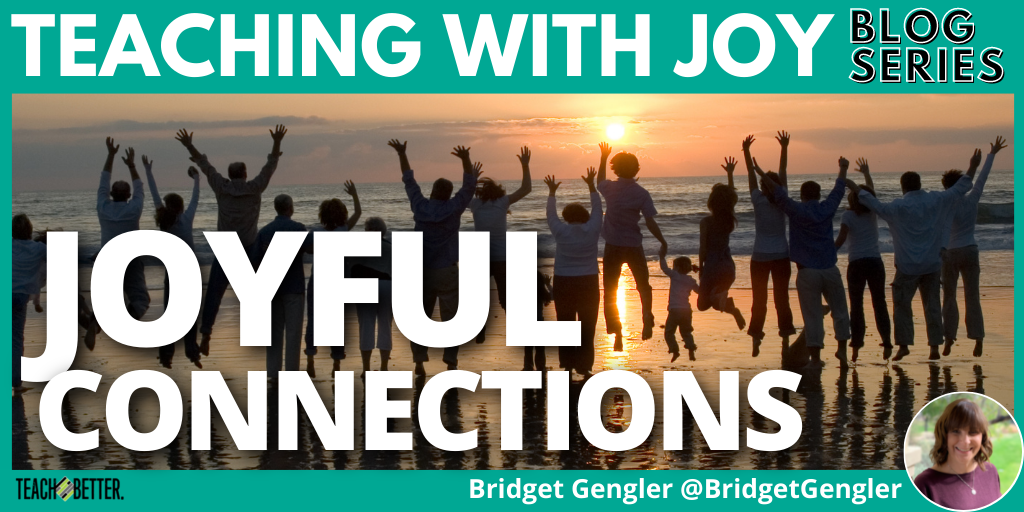TL;DR:
- Children need to know that you care about them.
- Find ways to connect and listen to your students.
- Greeting students, morning meetings, small talk, and laughter are great ways to connect.
As educators, I think we all can agree that we want our students to succeed.
We want to see them flourish and thrive.
We want them to leave our classrooms better than they were when they arrived.
Right?
But, how?
How do we ensure that what is happening in our classroom is going to benefit and help our students succeed?
“Children don’t care how much you know until they know how much you care.” – John Maxwell
When students walk into our classrooms on the first day of school, they are entering an unknown space that for most, holds no meaning or connection to them. The majority of them do not know you. They may be full of many emotions—nervousness, anxiety, excitement, or even complacency. They may be full of curiosity. But how do we grab their attention? How do we make them feel that they are important in this space? How do they know that they matter and that we care?
When they see someone who cares, they will perform better. They want to know that you are on their side and you are cheering for them. Click To TweetAs John Maxwell says, they don’t care about how much we know or how much we have to teach them until they know and feel how much we truly care about them.
But how do we build that care? How do we show them that we care?
Connection is key and that is where true joy in our job can be found.
How do we make those connections?
Greetings at the Door
Greeting students at the door is such an integral and necessary part of the day. It is important that they know they are seen. It is important they know we know who they are. Especially for the quiet students who potentially could become “invisible” inside the classroom. Greetings set the tone for the day. They build the classroom community. They make students feel that they are entering a safe zone—a place where they are loved and cared for.
Morning Meetings
Morning meetings are a wonderful way to make these connections. They offer time for the classroom community to come together and bond. It is a time to check in with each other and begin the day with positivity. It is a time to be intentional with the topics discussed. My co-teacher and I make sure that we think about topics to discuss that are relevant to what is happening in the classroom community, especially when it pertains to social-emotional needs.
Encourage them to share their voices.
Morning meetings provide opportunities for the students to share their voices. They create a safe place for them to share thoughts, perspectives, and opinions. They also allow us the chance to learn more about them in order to make meaningful connections throughout the day. Morning meetings provide us with talking points when we are making those connections. Thus, these connections make students feel that we are interested in them and who they are. In turn, they begin to see that we care.
Morning meetings establish belonging and agency. When morning meetings are part of the classroom routine, students start to feel comfortable and a classroom community is quickly established. They begin to feel that they are part of something bigger and that they belong in the environment. They feel comfortable communicating their thoughts and feelings, as well as voicing their opinions. This promotes student agency.
Take the time to listen.
If you take the time to listen to each student as they share, you can discover many things. Children want to be heard and know that what they say matters. I know we have busy days as educators to make sure that our students are receiving what they need in their learning time, but it is imperative that we stop to compassionately listen to what they have to say. There is that connection that sometimes we miss in our busyness. We may miss a connection that could be a turning point for one student. When our students see that we take time to hear what they have to say, they see someone who cares. When they see someone who cares, they will perform better. They want to know that you are on their side and you are cheering for them.
[scroll down to keep reading]Proximity
When you need to talk to a child, especially when they are having a difficult moment, proximity is important. Speaking to them while using a voice just for them will make them feel safe and also important. They will see that there is care in your response. Children tend to respond better in those moments.
Laughter
It is so important to enjoy some laughter in your classroom. Sharing a moment of laughter together is good for the soul. It adds to the community. It helps them to see that not every moment has to be serious and there is a time for smiles and laughter.
All of these things build a strong classroom community where students feel safe, comfortable, important, and loved. They see that you care. When they see that you care, they will perform to their highest capabilities. They have the potential to soar much higher than they did before. They have many successes, and no matter how big or small they may be, they are successes. You will see growth in them—academically and socially. You will begin to see more than just children walking into your room every day. And you will see people—unique and important in their own way that all contribute something to the classroom environment.
Joyful Connections
Connections sustain the joy for me in my teaching career. They are what keep me smiling and excited for the day.
The smiles on the children’s faces as they enter the classroom with a high five or fist bump.
The laughter that we share.
The voices that share their thoughts, opinions, and perspectives.
The encouragement they give each other.
The excitement in their learning.
The empowerment they feel when they are given the opportunity to shine.
All of that is pure joy that fills my grateful heart each day.
About Bridget Gengler
Bridget Gengler is a fourth grade teacher in Long Beach, California. She has taught bilingual education, general education, and GATE for the past 26 years. She’s passionate about building relationships and a strong classroom community that opens up doors of success for her students. She strives to empower all students to share their voices and their stories. Her class motto is “ You matter! You are important! You have a story to tell and we want to hear it!” She brings her love of reading and writing to the classroom in the hopes that it will promote lifelong readers and writers.
Bridget believes that self-care is essential in an educator’s life. She takes time to focus on gratitude, mindfulness and kindness during the day. She contributes this balance to her success in the classroom.
Family is number one for her! Her most precious job is being a mom to four young adults, an energetic lab puppy, and a wife to a wonderful husband. When she is not teaching, writing or reading she is creating memories with them. They love to travel, discover new restaurants, and watch professional baseball.





